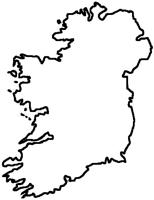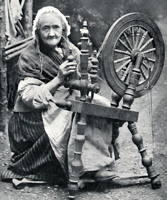
|
The Society of Folk Dance Historians (SFDH)
Folk Dance Traditions of Ireland
[
Home |
About |
Encyclopedia | CLICK AN IMAGE TO ENLARGE |

|
 "Ceili" (also "céilí" – Old Irish and "ceilidh" – American) dances reached their codified forms in the early part of this century, their first published form being in the first decade starting with an earlier edition of O'Keefe and O'Brien, consisting of figures only; Sheehan, London, 1902; and one produced with the intent to standardize the dances published in 1906 by Cumann na Rinnce, the Gaelic League of New York. Extracted from already existing country dance traditions, the house dances, they were filtered through the Feis (an Irish language festival with competitions) circuit, eventually reaching their present pronounced exaggerated form – the styles of "An Coimisiun la Rince Gaelacha" and its dissenting offshoot "Cogal," both "Dance Commissiions."
"Ceili" (also "céilí" – Old Irish and "ceilidh" – American) dances reached their codified forms in the early part of this century, their first published form being in the first decade starting with an earlier edition of O'Keefe and O'Brien, consisting of figures only; Sheehan, London, 1902; and one produced with the intent to standardize the dances published in 1906 by Cumann na Rinnce, the Gaelic League of New York. Extracted from already existing country dance traditions, the house dances, they were filtered through the Feis (an Irish language festival with competitions) circuit, eventually reaching their present pronounced exaggerated form – the styles of "An Coimisiun la Rince Gaelacha" and its dissenting offshoot "Cogal," both "Dance Commissiions."
These modernized dances are the end result in a process of selection, rejection, adaption, and stylization toward the object of establishing a foundation for a distinct "National" form. What better way than to distort. The evolution of this new form was based on far older and less national traditions, the new being formal, affected, and highly competitive, something more for the staged and stodgy than for the stone floor of a cottage or the bare ground at the crossroads. One simply does not wear a uniform, keep the back as stiff as a board, point the right toe, or wear ringlets at a traditional house dance. It is a folk dance, not a military drill or masquerade.
Those involved in setting this new dogma were with the Gaelic League, a fiercely Nationalistic organization. There seemed to be a need for such fervor and extremes then, and bad and good came from it. Keep in mind though, that many of its staunch supporters would have all things "English" physically and violently purged from the countryside, and had their concept of a "new and improved" Irish Gaelic society shoved down the throats of the people, even to the loss and abuse of the beautiful regional and parish dialects and traditions.
 Many dances, tunes and traditions, versions and variations, suffered, and still do, the axe block approach to Nationalization. Many survive despite it. These self-appointed judges were moved by blind patriotism, not knowledge. They were a jury ignorant of the accused, of their own dance and musical history and heritage except as falsely and biasedly represented by such popular works of historical fiction as W. H. Gratton Flood's "History of Irish Music," 1913. They would haphazardly tag something as international as the "Swing" as a European or English perversion and ban it, though not effectively; while on the other hand they'd approve some newer artifice like costume and ringlets, or something as blatantly European in root as the square dance formations and the two-hand barn dances as officially Irish. They would also carry around with them a general disgust for the crasser and more base traditions, feeling they should reflect their idealized fantasy of what Gaelic aristocracy was. All the steps and figures in their basic form are European, their earliest introduction being at least the 1400s. Prior to that, the only claim Ireland might have to dance could be acrobatic (that is, with a sword), theatrical (Morris-like), and possibly religious and line dances, now mostly gone from the tradition though the solo-dance has evolved in part from crossed-sword dances, and some wren-boy dances have carried over from theatrical dances. The "English" mania is as bizarre as the European witch craze of the 1500s and 1600s, and the McCarthyism of the 1950s.
Many dances, tunes and traditions, versions and variations, suffered, and still do, the axe block approach to Nationalization. Many survive despite it. These self-appointed judges were moved by blind patriotism, not knowledge. They were a jury ignorant of the accused, of their own dance and musical history and heritage except as falsely and biasedly represented by such popular works of historical fiction as W. H. Gratton Flood's "History of Irish Music," 1913. They would haphazardly tag something as international as the "Swing" as a European or English perversion and ban it, though not effectively; while on the other hand they'd approve some newer artifice like costume and ringlets, or something as blatantly European in root as the square dance formations and the two-hand barn dances as officially Irish. They would also carry around with them a general disgust for the crasser and more base traditions, feeling they should reflect their idealized fantasy of what Gaelic aristocracy was. All the steps and figures in their basic form are European, their earliest introduction being at least the 1400s. Prior to that, the only claim Ireland might have to dance could be acrobatic (that is, with a sword), theatrical (Morris-like), and possibly religious and line dances, now mostly gone from the tradition though the solo-dance has evolved in part from crossed-sword dances, and some wren-boy dances have carried over from theatrical dances. The "English" mania is as bizarre as the European witch craze of the 1500s and 1600s, and the McCarthyism of the 1950s.
Popular dance and musical traditions in Europe spread as quickly as the use of chocolate did after its first introduction from South America. The proliferation of music and dance was ann easy one of popular choice and fashion, travelling dance masters and returning travellers – it was not a painful conquest. An example is the coveted "reel," first introduced to Scotland via Europe. It was the Scottish that gave us its present identity. Reaching Ireland in the last half of the 1700s via Scotland, the reel was given a new Irish feeling and identity. As the Black Forest Gateaux is now a European tradition, so too dances and music settled into different areas and in time assumed a national, regional, and, as in the case if Ireland, parish and village identities. Sometimes the figures and the steps would be little changed from their basic form, but the style and the people would make it distinct to it's area of occurrence. An Irish Mazurka, Varsouvienne, or Polka is neither Polish nor Czech, no matter where the seed blew in from. Would the Irish ban the potato from their soil because it originated elsewhere?
Folk dance tradition to be living tradition must retain its flexibility, its traits of adaptability and innovation, of individual and group expression. Unfortunately, in this media-soaked world, it is hard for traditions to survive, and some guidelines and organization are called for; not to restrain or stifle, but to promote both occurrence and the understanding necessary to retain a distinct national character; a country's spirit expressed through its traditions. But the dance must remain with its trustees, the folk. And organization can only provide guidance and the means – a healthy medium or environment – only the people can sustain a tradition. If its surviving sum is in competition, the folk, it is a social occasion, light and amiable, may it always be.
As one person described the "Commission" versions, "Their pickled abstracts, stinkin' of Fermaldahyde – as formal as rigor mortus." Too many traditions have died such a death of false representation. Those born with the Irish language sing it so sweetly and beautifully in their own particular dialect, those who have acquired the "new and improved" Irish (based on 17th century Munster poetry, a formal written form) are most often clumsy and harsh with it. Those born to the dance live with it with spirit and with an honest interest. The "Commissions" are similar to the "Federated Square Dance" Organizations that give American dance tradition such a poor and false representation. These cadres are not tradition but cheaply based on it, sad mockeries. Such groups could serve a positive end in supporting the continued occurrence and spread of traditional music and dance, both still viable socially, if they would listen to the carriers of said tradition, musicians and dancers, instead of trying to confine them in a straight-jacket of dogma. Unfortunately though, there are a few exceptions in certain individuals and branches, they have probably gone too far in the wrong direction to now suddenly work to adjust their philosophy toward more constructive ends. They have grown stale, and the disease is a clique that is well entrenched. Much damage has been done to Irish traditions by their practices, most notable in their contributions toward the growing rift between music and dance, performer/competitor/"expert" and the folk.
There are organizations that are benefiting the traditions, most notable "Na Piobairi Uilleann," the sponsors of the most constructive gathering for the cause "Scoil Samraidh Willie Clancie" (The Willie Clancy Summer School). There are other organizations too, such as the one Paddy Glakin helped to form in dedication to the northern fiddlers of Ulster. "Comhaltas Ceoltoiri Eirann" has done much good, especially certain of the individual branches, but it too suffers from dogma and an entrenched clique in need of new blood and a fresh philosophy. C.C.C has too many misdirected priorities and tends to advocate a dogma that enforces standardization and raises superheroes up on pedestals, too competition-oriented with its self-appointed experts and false standards, judging people by their acquaintance and popularity in too many cases.
One incident of many was at the all-Ireland "fleadh" not too long ago when a judge condemned the Ulster tradition of singing, one of the finest, as a foul perversive influence on what he considered the "true" tradition, and then gave first-place to an over-vibratoed crooner who had ben classically trained. Despite this, many of the C.C.E. branches retain a special and individual identity, and excellence of intimacy and honesty, the weekly meetings and summer Oiche Cheilis being worth the experience. "Na Piobairi Uilleann" is still the best thing going having taken the most positive and constructive direction, de-emphasizing competition and focusing its energies toward workshops, gatherings, publications, classes, et cetera. They make the traditions happen, give them life and exposure, and yet still keep to their main goal – an organization for the promotion of the Uilleann pipes and pipers, all aspects of instrument construction.
Anyone with a serious interest should read Breandan Breathnach's book "Folk Music and Dances of Ireland" put out by the Mercier Press, Dublin, 1971. He has had a great influence on me. I would also highly recommend "The Northern Fiddler" compiled by Allen Feldman and Eamon O'Dogherty Balckstaff Press, Belfast, 1979, and Henry Glassie's works.
DOCUMENTS
- Ireland, a country.
- Irish Set vs. Céilí Dancing, an article.
- Northern Ireland, a country.
- Set Dances of Ireland, an article.
Used with permission of the author.
Reprinted from the 1991 University of the Pacific (Stockton) Folk Dance Camp syllabus.
This page © 2018 by Ron Houston.
Please do not copy any part of this page without including this copyright notice.
Please do not copy small portions out of context.
Please do not copy large portions without permission from Ron Houston.